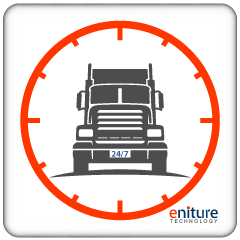The Real Time Shipping Quotes app for Bigcommerce retrieves your negotiated shipping rates, takes action on them according to the app settings, and displays the results as shipping options during checkout. The app can be configured to quote parcel and LTL freight shipments. See the Providers tab below for a list of supported shipping companies.
Promotional Video (1 minute)
Setup Tutorial & Demo (10:30 min)
Basic Plan $30/month
Retrieves your negotiated LTL freight rates for the enabled LTL freight provider.
Supported origins: United States and/or Canada depending on the capabilities of the enabled LTL freight provider.
Supported destinations: United States and/or Canada depending on the capabilities of the enabled LTL freight provider.
Customize the text used to label LTL freight quotes displayed to shoppers.
Options for how to offer lift gate delivery including an option to require lift gate delivery when the address type is identified as residential.
Specify the weight of your handling unit (e.g. pallet) so that it is accounted for in the shipping quote.
Identify the maximum weight per handling unit to extrapolate the number of handling units to account for in the shipping quote.
Retrieves your negotiated parcel rates for the enabled parcel shipping provider.
Supported origins: United States and/or Canada depending on the capability of the enabled provider.
Supported destinations: Any country that Fedex, Purolator, or UPS provide service to. Some UPS resellers available in the app will not return a quote to destinations outside the United States.
Select which services to offer to your shoppers.
Mark up or mark down individual services by a dollar amount or percentage.
Retrieve hyper-accurate parcel quotes even when charges are based on dimensional weight when using the built in packaging algorithm. Use of the optional Standard Box Sizes feature required.
Elect to include insurance in the shipping quotes when specific products are in the shopping cart.
Elect to display the carrier’s transit time or estimated delivery date with the rate estimate.
Define multiple warehouse locations.
Identify products that drop ship from vendors.
Use shipping groups to offer free or flat rate shipping rates for specific products.
Always quote shipments as going to commercial or residential addresses or have the app automatically detect the address type to dynamically include the residential delivery fee in the shipping quotes.
Choose not display shipping quotes if a post office box is detected.
Mark up quotes by a dollar amount or percentage.
Support for products that ship hazardous material.
Offer an option for in-store pick up based on the customer’s distance from your warehouse.
Offer local delivery based on the customer’s distance from your warehouse.
Charge a fee for local delivery.
Dynamic presentation of LTL freight and parcel rates when both types of providers are enabled.
Connect easily to FreightDesk Online to process shipments, print BOLs and shipping labels, and schedule pickups.
Standard Plan $55/month
Enable up to three shipping providers.
Advanced Plan $75/month
Enable up to five shipping providers.
LTL Freight Providers
C.H. Robinson / Freightquote by C.H. Robinson (Origins: Canada, USA | Destinations: Canada, USA)
Central Transport (Origins: USA | Destinations: Canada, USA)
Day & Ross (Origins: Canada, USA | Destinations: Canada, USA)
Daylight Transport (Origins: USA | Destinations: Canada, USA)
Distance Based Shipping Rates (Origins: Any | Destinations: Any)
Echo Logistics (Origins: USA | Destinations: USA)
Estes Express (Origins: USA | Destinations: Canada, USA)
FedEx Freight (Origins: Canada, USA | Destinations: Canada, USA)
GlobalTranz (Origins: USA | Destinations: Canada, USA)
Kuehne+Nagel (Origins: USA | Destinations: Canada, USA)
Old Dominion Freight Lines (ODFL) (Origins: USA | Destinations: Canada, USA)
Priority1 (Origins: USA | Destinations: Canada, USA)
R+L Carriers (Origins: USA | Destinations: Canada, USA)
SAIA (Origins: USA | Destinations: Canada, USA)
Southeastern Freight Lines (SEFL) (Origins: USA | Destinations: Canada, USA)
TForce (formerly UPS Freight) (Origins: USA | Destinations: Canada, USA)
TQL (Origins: USA | Destinations: USA)
Unishippers (Origins: USA | Destinations: Canada*, USA *Requires New API)
Worldwide Express (Origins: USA | Destinations: Canada*, USA *Requires New API)
XPO Logistics (Origins: USA | Destinations: Canada, USA)
Parcel Shipment Providers
FedEx (Origins: Any country serviced by FedEx | Destinations: Any country serviced by FedEx)
Purolator (Origins: Canada | Destinations: Any country serviced by Purolator)
Unishippers (Origins: USA | Destinations: Any country serviced by UPS)
UPS (Origins: Canada, USA | Destinations: Any country serviced by UPS)
UPS via ShipEngine (Origins: USA | Destinations: Any country serviced by UPS)
US Postal Service (Origins: USA | Destinations: Any country serviced by USPS)
Worldwide Express (Origins: USA | Destinations: Any country serviced by UPS)
Current version: 1.0
Requirements
A BigCommerce online store.
An established account with the shipping company or companies you intend to enable in the app.
FAQs
How do I get support for this application?
The knowledge base is the best 24/7 resource for support. Click here to go to the knowledge base. You can open a support ticket by emailing support@eniture.com. Customer support can also be contacted by phone at 404-369-0680 x2 on business days between 9:00 AM and 5:00 PM Eastern Time. If you get voicemail, leave a message and we will return your call.
How do I get an account?
Instructions for how to obtain an account with a shipping provider is available in the app. Follow the steps to enable the shipping provider to see the instructions for that provider.
Why are the shipment charges I received on the invoices from my carriers different than what was quoted by the plugin?
Common reasons include a difference in the quoted versus billed shipment parameters (weight, dimensions, freight class), or additional services (such as residential delivery) were required. Compare the details of the invoice to the shipping settings on the products included in the shipment. Consider making changes as needed. Remember that the weight of the packing materials is included in the billable weight for the shipment. If you are unable to reconcile the differences call the freight carrier for assistance.
Why do I sometimes get a message that a shipping rate estimate couldn’t be provided?
There are several possibilities:
The most common reason is that one or more of the products in the shopping cart didn’t have its shipment parameters (weight, dimensions, freight class) adequately populated. Check the settings for the products on the order and make corrections as necessary.
The city entered for the shipping address may not be valid for the postal code entered. A valid City+State+Postal Code combination is required to retrieve a rate estimate.
Your shipment exceeded constraining parameters of the provider’s web service.
The shipment destination isn’t serviced by the provider.
The provider’s web service isn’t operational.
Your account with the provider has been suspended or cancelled.
There is an issue with the Eniture Technology servers.
There is an issue Shopify’s servers.
How do I determine the freight class for my product(s)?
The easiest thing to do is to contact your provider and ask for assistance. However, the official source is the National Motor Freight Classification (NMFC) directory maintained by the National Motor Freight Transportation Agency (NMFTA.org). You can purchase a hard copy of the directory or obtain an online subscription to it from their web site.
How does the density calculator work?
The density calculator will calculate a freight class by performing a calculation using the product weight and dimensions as inputs. In most cases the returned freight class will match the product’s (commodity’s) freight class as recorded in the National Motor Freight Classification (NMFC) directory. However, this is not always true and in the event there are differences, the freight class recorded in the National Motor Freight Classification (NMFC) directory takes precedence. An incorrectly identified freight class can result in unexpected shipping charges and even fees. You are solely responsible for accurately identifying the correct freight class for your products. If you need help doing this, contact your LTL freight provider for assistance.
User’s Guide
Complete the steps below to install and setup the Real-time Shipping Quotes application.
- Install the Real-time Shipping Quotes application.
- Prepare BigCommerce to use the application.
- Choose a subscription plan.
- Enable the integrations for your shipping providers.
- Connect to The Provider’s API.
- Select LTL Freight Carriers (3PL only)
- Choose the Desired Quote Settings
- Identify your warehouse and drop ship locations.
- Address Type Settings
- Shipping Groups.
- Shipping Rules.
- Box Sizes.
- Pallets.
- Product Settings.
- Updating Products with the Import CSV Utility or API.
- Orders
Other information contained in this guide:
1. Install the Real-time Shipping Quotes application. |
Return to top. |
Navigate to Apps > Marketplace. Click on the BIGCOMMERCE.COM/APPS button to access the app marketplace.

Search for “Real-time Shipping Quotes”. When it is displayed in the search results, click on the product badge to access the app information page. Click on the GET THIS APP button to initiate the installation wizard. Complete the installation process. At the conclusion of the installation process you’ll see the Real-time Shipping Quotes app displayed in the list of your installed apps.
2. Prepare BigCommerce to use the application. |
Return to top. |
Use the BigCommerce ADMIN menu to navigate to Settings > Shipping. Make sure the toggle for Choose which shipping options will be powering checkout is set to Default.

If you don’t have the desired shipping zone already defined, click the Add shipping zone button and select an option from the dropdown list.
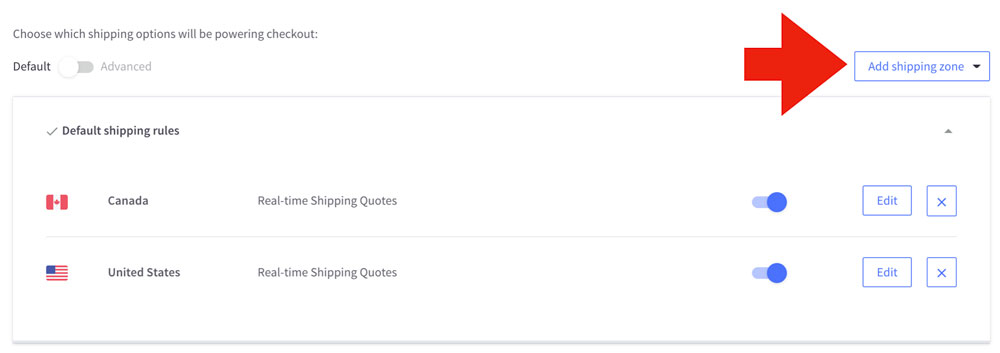
Complete the process of creating the shipping zone.
If you created a new shipping zone, click on the Configure button. If you are adding the app to an existing shipping zone, click on the Edit button. Scroll down the page until you see the section titled, Real-time shipping quotes. Locate the Real-time Shipping Quotes by Eniture Technology app in the list of installed apps and then toggle the slider to enable it.

You’ll be presented with a popup. Click the Submit button. All of the settings are controlled in the app, so you don’t need to enter any information in the popup.
3. Choose a subscription plan. |
Return to top. |
Navigate to Apps and click on Real-time Shipping Quotes in the list of installed apps. In the app navigation menu, click on Plans.
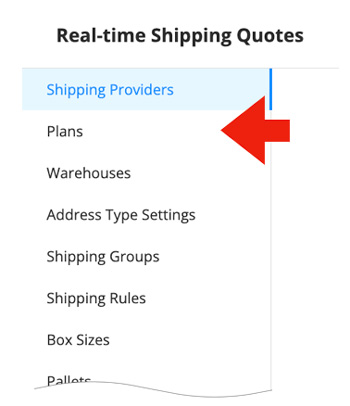
The Plans page is used to confirm the plan you are currently subscribed to, see the features offered on each plan, and to perform upgrades or downgrades according to your needs. The monthly subscription rate button of the plan you’re currently subscribed to will have a white fill color. To change plans, click on the subscription rate button of the plan you’d like to be on.
When you select a plan you’ll be prompted to enter a credit card to pay for the subscription, or choose to use one already on file. Complete the process of identifying the payment method you’d like to use to activate the subscription.
4. Enable the integrations for your shipping providers. |
Return to top. |
Click on Shipping Providers in the app’s navigation menu.
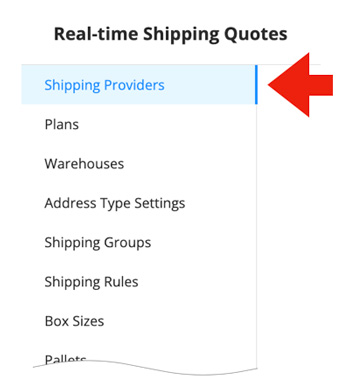
Use the Shipping Providers page to add the shipping providers that you want to enable in the app. You can activate as many as allowed by the selected plan. Locate the shipping provider in the All Providers section of the page, and click on its Add account link.

Afterward, it will appear in the section with the heading, Installed Providers.

Repeat this step for each provider you want shipping quotes from.
5. Connect to The Shipping Provider’s API |
Return to top. |
Now connect to the provider’s API (Application Programming Interface). Click on its Connection settings link.

Click on the link for the provider in the list below for provider-specific instructions. The instructions will load in a new tab in your browser. Repeat this step for each provider you want to activate. After successfully connecting to the provider(s), return to these instructions and continue to the next step.
List of supported providers
C.H. Robinson / Freightquote by C.H. Robinson
Central Transport
Day & Ross
Daylight Transport
Distance Based Shipping Rates – An account specific API connection is not required. Continue to next step.
Echo Logistics
Estes Express
Fedex Freight
GlobalTranz
Kuehne+Nagel
Old Dominion Freight Lines (ODFL)
Priority1
R+L Carriers
SAIA
Southeastern Freight Lines (SEFL)
TForce (formerly UPS Freight)
TQL
Unishippers
Worldwide Express
XPO Logistics
Fedex
Purolator
Unishippers
UPS
UPS via ShipEngine Carriers
US Postal Service – An account specific API connection is not required. Continue to next step.
Worldwide Express
6. Select LTL Freight Carriers (3PLs only) |
Return to top. |
The Carriers link will be present only if you are configuring a shipping provider that is a Third-party Logistics provider (3PL).

3PLs provide access to a portfolio of asset based LTL freight carriers through a single account relationship. The Carriers settings are unique to each 3PL. If you have more than one 3PL provider enabled, the selections you make on a provider’s Carriers page will be specific to that provider. Enable as many carriers as possible, disabling only those that you’ve had a bad experience with in the past.
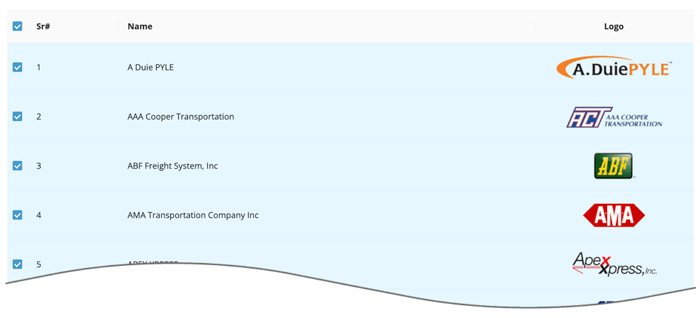
7. Choose the Desired Quote Settings |
Return to top. |
A shipping provider’s quote settings determine the unique behavior of its integration. The quote settings for a given provider apply only to that provider although other providers can have similar settings. For example, all of the providers have a setting for Handling fee / markup. A handling fee entered for Provider A will have no effect on Provider B. To access a provider’s quote settings page, click on its Quote Settings link.

Click on the link for the provider in the list below for provider-specific instructions. The instructions will load in a new tab in your browser. Repeat this step for each provider you want to activate. Afterward, return to these instructions and continue to the next step.
List of supported providers
C.H. Robinson / Freightquote by C.H. Robinson
Central Transport
Day & Ross
Daylight Transport
Distance Based Shipping Rates
Echo Logistics
Estes Express
Fedex Freight
GlobalTranz
Kuehne+Nagel
Old Dominion Freight Lines (ODFL)
Priority1
R+L Carriers
SAIA
Southeastern Freight Lines (SEFL)
TForce (formerly UPS Freight)
TQL
Unishippers
Worldwide Express
XPO Logistics
8. Identify your warehouse and drop ship locations. |
Return to top. |
Select Warehouses from the app’s navigation menu.
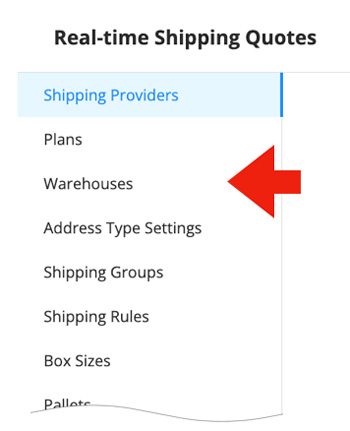
The warehouse and drop ship location settings are common to all of the enabled shipping providers. To add a warehouse or drop ship location, select Warehouses from the app’s navigation menu.
There are two types of stocking locations in the app: 1) Warehouse locations; 2) Drop ship locations. Products can be assigned to a drop ship location. When a product assigned to a drop ship location is in the shopping cart, it is always quoted as shipping from that location. A product can only be assigned to a single drop ship location. All products not assigned to a drop ship location are considered to be available at the warehouses. If you have more than one warehouse defined, the warehouse closest to the ship-to address is used as the ship-from address.
A best practice is to define at least one warehouse, even if all your products are drop shipped. If all your products are drop shipped (you have no warehouses), make the highest volume drop ship location a warehouse. This ensures that shipping rate estimates will still be returned in the event a product was added to your catalog and its drop ship location wasn’t identified.
Warehouses vs. Drop Ship Locations
How the Plugin Presents Quotes with Multiple Shipment Origins
Click the Add button to identify a new warehouse or drop ship location and populate the location parameters according to the following instructions:
| Nickname | Enter a nickname for the location. The nickname is only visible on the Warehouses page and on the Order Details page after an order is placed. It isn’t visible to visitors to your online store. |
| Street Address | Enter the street address for the location. The street address is particularly important if you intend to use the In-store Pick Up or Local Delivery features because it is used to determine the distance between the location and the ship-to address. |
| Unit Number | If the location has a building, suite, or apartment number enter it here. |
| Postal Code | Enter the postal code for the location. Use only the 5-digit ZIP code for US addresses. |
| City | Enter the name of the city for the location. |
| State | Enter the standardized two character abbreviation for the state of province. |
| Country | Enter the standardized two character abbreviation for the country. |
| Account Number | This setting will be visible only if you have an integration enabled for a shipping provider that requires a unique account number for each physical shipping-from address. If you have such an integration enabled and have been provided with an account number specific to this address, enter it here. |
8a. In-store pick up settings |
Return to top. |

| Enable in-store pick up | Check the box to enable the in-store pick up feature. |
| Offer if address is within (miles) | The distance in miles within which you’d like to offer in-store pick up. The distance is route miles (driving distance). Leave blank if you don’t want to use distance to determine if in-store pick up should be offered. If both distance and postal codes are used as evaluation criteria, in-store pick up will display if either condition is satisfied. |
| Offer if postal code matches | Enter the postal codes to which you’d like to offer in-store pick up. Enter only the five digit ZIP Code for US addresses. Separate postal codes with a comma. Leave blank if you don’t want to use postal codes to determine if in-store pick up should be offered. If both distance and postal codes are used as evaluation criteria, in-store pick up will display if either is satisfied. |
| Show distance between pick up location and receiver address | When enabled, the miles between the pickup location and the receiver address is included in the shipping method description. |
| Show pick up location address | When enabled, the the pickup location address is included in the shipping method description. |
| Show pick up location phone number | When enabled, the the pickup location phone number is included in the shipping method description. |
| Checkout description | Enter the description to use to identify the option in the checkout process. The most obvious candidate is In-store pick up, but you can make it anything you’d like. |
| Phone number | Enter the phone number you’d like to present to the shopper in the event that there is a question about in-store pickup. |
| Origin for shipping rates | This location (default) Uses the location’s physical address as the ship-from address in the event that shipping rates will also be offered. Suppress carrier-provided shipping rates
If the ship-to address is within the miles entered for the Offer if address is within (miles): setting or has a postal code that matches the Offer if postal code matches: setting, then carrier-provided shipping rates will not be presented to the visitor. Other
If you offer in-store pickup from this location, but ship orders that aren’t being picked up at this location from another address, choose this option. You’ll be prompted to enter the postal code, city, state/province, and two character country code. |
8b. Local delivery settings |
Return to top. |
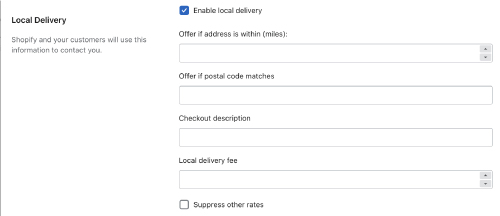
| Enable local delivery | Check the box to enable the local delivery feature. |
| Offer if address is within (miles) | The distance in miles within which you’d like to offer local delivery. The distance is route miles (driving distance). Leave blank if you don’t want to use distance to determine if local delivery should be offered. If both distance and postal codes are used as evaluation criteria, local delivery will display if either is satisfied. |
| Offer if postal code matches | The postal codes to which you’d like to offer local delivery. Enter only the five digit ZIP Code for US addresses. Separate postal codes with a comma. Leave blank if you don’t want to use postal codes to determine if local delivery should be offered. If both distance and postal codes are used as evaluation criteria, local delivery will display if either is satisfied. |
| Checkout description | The description to use to identify the option in the checkout process. The most obvious candidate is Local delivery, but you can make it anything you’d like. |
| Local delivery fee | Enter the amount to charge for local delivery. Leave blank to offer local delivery for free. |
| Suppress other rates | Check the box to show only the option for local delivery when the criteria for doing so (distance or postal code) is met. Only the rates from this app will be suppressed. If you have other shipping methods enabled for your store, they will be unaffected by this setting. Leave the box unchecked to have local delivery offered in addition to the shipping options normally displayed by the app. |
9. Address Type Settings. |
Return to top. |
Select Address Type Settings from the app’s navigation menu.
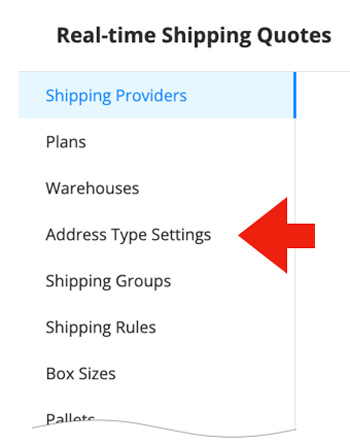
| Do not return rates if the shipping address appears to be a post office box | Enable this setting if you don’t want the application to present shipping quotes when the ship-to address appears to be a post office box. When the Automatic Address Detection feature is disabled, text string matching is used to identify post office boxes. This method is not infallible or guaranteed. When the Automatic Address Detection feature is enabled, post office boxes in the United States are reliably identified through an API sourced from the US Postal Service. Text string matching will continue to be used for other countries. |
| Always quote residential delivery | Enable this setting if all quotes should include the shipping provider’s residential delivery fee. |
| Automatic Address Detection | When enabled, the ship-to address is checked against a USPS database to determine if it is a residential address. If it is, the shipping quote will automatically include the carrier’s residential delivery fee. This feature is billed separately and is charged to the same payment method used to pay for the app. The selected plan is decremented each time the address type is confirmed. The plan automatically renews at the beginning of the next billing cycle, or when the plan is fully depleted, which ever comes first.
Auto-renew
Select the plan that will be in effect at the next renewal. Choose Disable from the dropdown to cancel it. Current plan
This information is read-only. It conveys the active plan, and the current plan’s start and end date. Current usage
This information is read-only. It conveys how much of the current plan has been consumed. Suspend use
Enable this setting to temporarily suspend the address type detection feature. Enabling this setting does not cancel the feature. The setting is typically used for testing purposes. Default unconfirmed address types to:
In rare cases, the plugin may be unable to confirm the address type. This occurs when a match for the address can’t be found in the USPS database. Invalid addresses are the most common reason for this. In extremely rare cases an address may be valid, but the match found in the USPS database has a low confidence metric. Choose how you want addresses treated in these cases. Residential
Choose this setting if you want unconfirmed addresses to be treated as residential. Commercial
Choose this setting if you want unconfirmed addresses to be treated as commercial. Address type disclosure
Applies only when the ship-to address is in the USA. Inform the shopper when the ship-to address is identified as residential
Choose this setting when you want to inform the shopper that their ship-to address has been identified as a residential address. Don’t disclose the address type to the shopper
Choose this setting if you don’t want to inform the shopper when their ship-to address has been identified as a residential address. |
10. Shipping Groups. |
Return to top. |
“Shipping Groups” allow you to define a custom shipping rate that can be applied to one or more products. This is an optional feature and the most common use of it is for free shipping or for a flat shipping rate to charge for specific items. Once you define a Shipping Group, you can assign one or more products to it. For example, if you define a “Free Shipping” shipping group, any product that you associate with the group will enjoy free shipping. Associating a product to a shipping group is done on the product shipping parameters page (see the section titled Product Settings). A shipping group must be defined before products can be assigned to it.
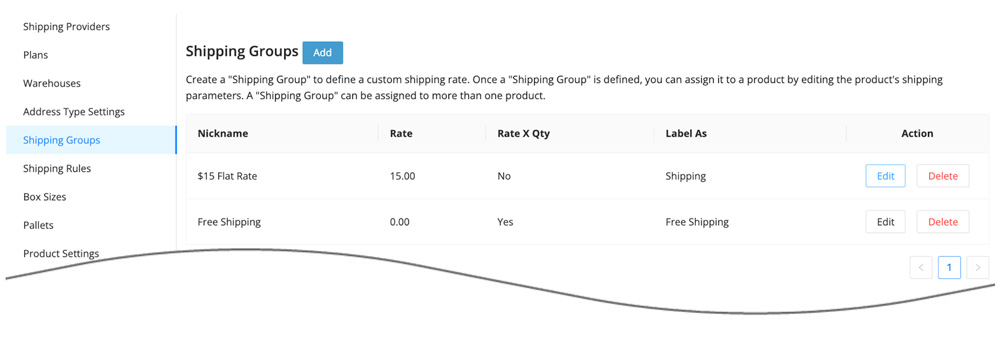
If the Cart contains items that are associated with a shipping group and items whose shipping charges are to be identified with real-time shipping quotes from a shipping carrier, the rate(s) for the shipping group will be added to the real-time rates provided by the shipping carrier. For example, if UPS were to return a shipping rate estimate for UPS Ground service of $15, and the shipping group rate for one of the items in the Cart was $5, then the site visitor would see a quote for UPS Ground service of $20 (= $15 + $5).
If the Cart contains items that are associated with different shipping groups and none of the items are set up to receive a real-time shipping quote, then the rates of the different shipping groups will be added together and the combined rate presented to the site visitor as “Shipping”.
Click the Add button to add a new shipping group and refer to the instructions below.
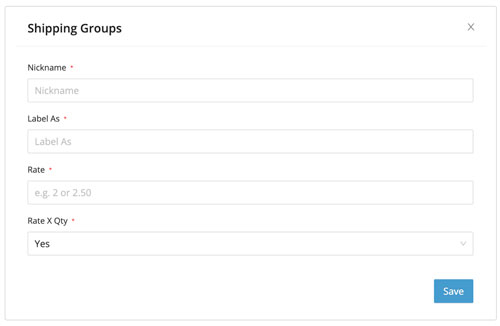
| Nickname | Enter a nickname for the shipping rate. This will not be seen by your site visitors. It is for internal reference only. |
| Label As | Enter a description for the rate that will be seen by site visitors. For example, if the shipping group is for free shipping, you might enter “Free Shipping” in this field. |
| Rate | Enter the amount for the shipping rate. Enter “0.00” for free shipping. |
| Rate X Qty | If you want the rate to be multiplied by the quantity of items that are in the Cart that belong to this shipping group, select Yes from the drop down menu. Otherwise, select No. |
11. Shipping Rules |
Return to top. |
Select Shipping Rules from the app’s navigation menu.
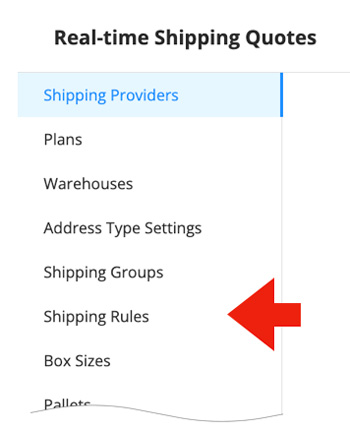
The Shipping Rules page gives you an opportunity to customize the behavior of the app. Click the Add button to create a rule.
| Rule Name | Enter a name for the rule. The name is for your convenience. It will not be seen by your customers. |
| Type: Flat Shipping Rate | This rule presents a flat rate for shipping when the filters are satisfied.
The following settings apply… Apply to:
The option for Shipment is pre-selected and is the only option for this rule type. Flat Shipping Rate
Enter the rate you want offered for the flat shipping rate. Multiply flat shipping rate by Cart quantity
Enable this checkbox if you want to multiply the flat shipping rate by the quantity of items in the Cart. |
| Type: Hide Delivery Estimates | This rule will suppress the delivery estimates when the filters are satisfied.
The following settings apply… Apply to
The option for Cart is pre-selected and is the only option for this rule type. Provider
Select the shipping provider for whom the rule shall apply. |
| Type: Hide Methods | This rule will hide the shipping rates returned by a specified provider when the filters are satisfied.
The following settings apply… Apply to:
The option for Cart is pre-selected and is the only option for this rule type. Provider
Select the provider whose results you want to hide if the filters are satisfied. |
| Type: Large Cart Settings | This rule will impacts parcel quoting apps only.
If you can have Carts that contain a large number of items, and a large number of boxes defined, it may take the packaging algorithm more time to execute than is permitted by BigCommerce. In this case, it is desirable to bypass the packaging algorithm so that shipping quotes are still displayed during checkout. The following settings apply… Max items
Specify the quantity of items in the Cart that should activate the Large Cart Settings rule. Max weight per package
Enter the maximum weight that a package can contain. The total weight of the Cart will be divided by this value to identify the number of packages required for the shipment. The maximum permitted value is 150 LB. |
| Type: Override Rates | This rule will override the shipping rates returned by a specified provider when the filters are satisfied.
The following settings apply… Apply to:
Cart
When this option is selected, the Override Rates rule will apply to the Cart. Shipment
When this option is selected, the Override Rates rule will apply to the shipment. If more than one shipment is assoicated with the Cart contents, the rule may apply to some but not all of the shipments. Provider
Select the provider whose results you want to override if the filters are satisfied. Service
Select the service whose results you want to override if the filters are satisfied. Service rate
Enter the rate in dollars and cents that you want presented if the filters are satisfied. Enter “0” for free shipping. |
| Type: Restrict To Country | This rule will only allow shipping rates to be offered when the ship-to address in the specified country, and the enabled filters are satisfied.
The following settings apply… Apply to:
The option for Cart is pre-selected and is the only option for this rule type. Countries
Choose the two digit abbreviation for the country you want the rule to apply to. |
| Type: Restrict To State | This rule will only allow shipping rates to be offered when the ship-to address in the specified state or province, and the enabled filters are satisfied. The following settings apply… Apply to:
The option for Cart is pre-selected and is the only option for this rule type. Country
Identify the country in which the states or provinces you will identify belong. States/Provinces
Select the states or provinces you want to restrict rates to. The field will accept multiple entries. |
| Type: Restrict To Postal Codes | This rule will only offer shipping rates when the ship-to address is in particular postal codes, and the enabled filters are satisfied.
The following settings apply… Apply to:
The option for Cart is pre-selected and is the only option for this rule type. Country
Identify the country in which the states or provinces you will identify belong. States/Provinces
Select the states or provinces you want to restrict shipping rates to. The field will accept multiple entries. Postal Codes
Enter the postal codes you want to restrict shipping rates to. Postal codes can be entered with exact values (e.g., 90210), using wildcards (e.g., 902*), or as numeric ranges (e.g., 90210…99000). The field will accept multiple entries. Use the Enter key to add the next value. |
| Type: Restrict To Origin Locations | This rule will limit the shipping origin to only the specified warehouse locations when the enabled filters are sastisfied. The closest warehouse to the ship-to address will be used as the ship-from address. If the Cart contains other items that don’t result in the same ship-from address, then multiple shipping quotes will be collected and summarized in the checkout process as “Shipping”.
The following settings apply… Apply to:
The option for Cart is pre-selected and is the only option for this rule type. Warehouses
Identify the warehouses the product is restricted to shipping from. The warehouses must already be defined on the Warehouses settings page. |
| Type: Surcharge | This rule will add a specified amount to each quoted shipping rate estimate when the filters are satisfied.
The following settings apply… Apply to:
Cart
Select this option if you want the filters to apply to the entire contents of the Cart, and the surcharge to be added to the shipping rate estimates for the Cart. Shipment
Choose this option if you want the filters to apply to individual shipments associated with the Cart. This setting differs from the Cart settings if the contents of the Cart are quoted as shipping from different origins. For example, if you have dropship locations identified in the app for Nevada and Indiana, and the Cart contains items what are assigned to each, then the app will retrieve shipping rates from both locations, sum them, and present the total amount during checkout. If either shipment satisfies the filters, then the surcharge will be added to the shipping rates for that location and included in the total quoted rate. Service rate
Enter the amount of the surcharge that will be added when the filters are satisfied. |
| Filters | Below is a list of filters that can be used to target when a shipping rule is applied. Not every filter is available for each rule. The filters that are available for a shipping rule will appear on the settings page after the rule type is selected.
Filter by weight
Enable the checkbox if you want to use the weight of the cart as a criteria for the application of the rule. Enter the range for the weight in the From and To fields. The value entered in the From field will be included in the criteria. The value entered in the To field will be excluded from the criteria. If you enter “From 100” “To 150”, then a Cart with a total weight of 100 LBS will trigger the rule while a Cart with a total weight of 150 LBS will not. Consider the “To” field as the “Up to” value. Filter by price
Enable the checkbox if you want to use the price of the cart as a criteria for the application of the rule. Enter the range for the price in the From and To fields. The value entered in the From field will be included in the criteria. The value entered in the To field will be excluded from the criteria. If you enter “From 100” “To 150”, then a Cart with a total price of $100 will trigger the rule while a Cart with a total price of $150 will not. Consider the “To” field as the “Up to” value. Filter by quantity
Enable the checkbox if you want to use the quantity of items in the cart as a criteria for the application of the rule. Enter the range for the quantity in the From and To fields. The value entered in the From field will be included in the criteria. The value entered in the To field will be excluded from the criteria. If you enter “From 10” “To 20”, then a Cart containing 10 items will trigger the rule while a Cart with 20 items will not. Consider the “To” field as the “Up to” value. Filter by category
Select the category names. Multiple categories can be selected. Filter by brand
Select the brand names. Multiple brands can be selected. Filter by product
Identify the products for the filter. Use the type ahead feature to search by product name or SKU. Select the product from the search results. Filter by location
Enable the checkbox if you want to use the ship-to address as a criteria for the application of the rule. Select a country from the Countries dropdown field, and then the states or provinces from its dropdown field. You can add multiple countries, states or provinces to a rule. Apply rule…
Choose the radio button associated with the option on how you want the filters to apply to the rule. |
| Available | Enable this checkbox if you want the rule to be applied. Disable it if you want to keep the rule settings for future use, but you don’t want to actively apply it. |
12. Box Sizes |
Return to top. |
Select Box Sizes from the app’s navigation menu.
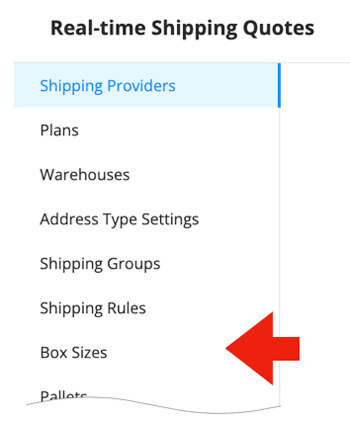
When the Standard Box Sizes add-on is in use, it allows merchants to identify the sizes of boxes that are kept on hand for shipping purposes. When the activity of an online shopper triggers the need for parcel shipping quotes, the programming examines the available boxes and identifies a packaging solution that is best suited for the contents of the cart. The packaging solution will result in the lowest shipping cost. A graphical illustration of the packaging solution will be saved with the order and can be viewed on the Orders tab in the app’s user interface. It will show the box(es) selected for the packaging solution and step-by-step illustrations of how each item in the cart was oriented and placed in the box.
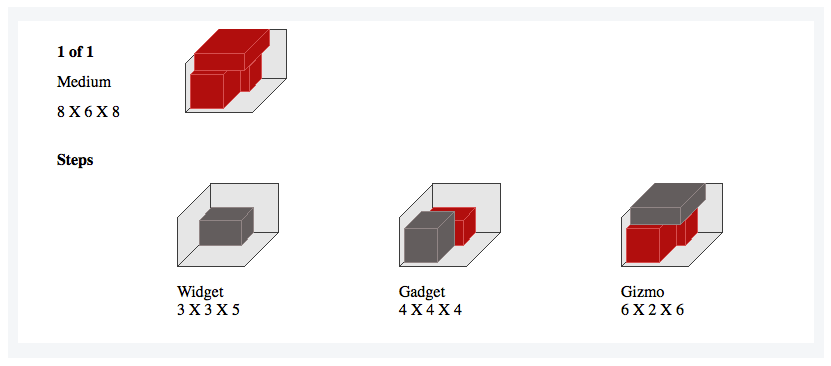
The Standard Box Sizes feature is important if you want to offer accurate parcel shipping rates to your customers. Parcel carriers like FedEx and UPS determine package charges based on billable weight, which is the greater of a package’s actual weight or dimensional weight. The size of the box used is a critical factor in determining dimensional weight. Learn more.
Charges for the Standard Box Sizes feature are usage based and are in addition to the monthly subscription you pay for the app. Plans for the Standard Box Sizes add-on begin at $5/month for 100 transactions, or 5¢ per transaction when the plan is fully depleted. Other plans are available. The largest plan will drop the rate to 1¢ per transaction when it is fully depleted. (View all subscription plans)
When the Standard Box Sizes add-on is enabled, a transaction occurs each time a packaging solution is obtained. A packaging solution is obtained prior to sending a request for shipping quotes to your enabled parcel shipping providers. If a visitor’s activity causes an additional request for shipping quotes and the contents of the cart have not changed, then the previously obtained packaging solution is used and an additional transaction will not occur.
Subscription plans renew when the current one expires or is fully depleted, whichever occurs first. To change plans, select a new option from the Auto-renew setting. When the current plan expires or is fully depleted, the new plan will be in effect.
| Auto-renew | Select the plan that best meets your needs. Plans renew when the current one expires or is fully depleted, whichever occurs first. To change plans, select a new option from the Auto-renew setting. When the current plan expires or is fully depleted, the new plan will be in effect. |
| Current plan | Read only. Informs you about the details of the plan currently in use. |
| Current usage | Read only. Identifies the number of transactions that have been used on the current plan. |
| Suspend use | Enable this setting if you wish to temporarily disable this feature. This setting doesn’t cancel the feature, it merely suspends it. If you encounter the end of a billing cycle with the feature suspended, the feature will be renewed for the plan you have selected in the Auto-renew setting. To cancel the feature, select Disable from the Auto-renew setting dropdown. |
| Optimize your packaging | The packaging algorithm arrives at a solution by prioritizing whether to minimize the amount of empty space in the packages (e.g. boxes) or by minimizing the number of packages in the shipment. For example, the packaging solution may yield two boxes with 5% of empty space when space utilization is prioritized, or one larger box with 20% of empty space if the number of packages is prioritized.
Space utilization in the package
Choose this option if you want the packaging algorithm to prioritize space utilization when arriving at a packaging solution. By number of packages
Choose this option if you want the packaging algorithm to prioritize the number of packages (fewer is better) when arriving at a packaging solution. |
| Packaging method when standard box sizes is disabled | Select which of these alternatives to use when the Standard Box Sizes is not in use. The Standard Box Sizes feature may not be in use because you chose not to enable it, you suspended it, the associated payment method could not be processed at renewal, or a technical issue prevented it from executing.
Quote each method as shipping as its own package
Each item in the Cart will be quoted as shipping as its own package. Unless orders are shipped this way, the shipping rate estimates using this method will tend to be high. Quote shipping as all items are in one packaged, using weight only
All the items in the Cart will be quoted as shipping in one box and the shipping rate estimates will be based on weight only. If the total weight of the Cart exceeds 150 pounds, the total weight will be divided in to multiple packages of equal weight. Shipping rate estimates using this method will tend to be low. Combine the weight of all items without dimensions and quote them as one package while quoting each item with dimensions as shipping as its own package
A hybrid of the other two options. Shipping rate estimates may be higher or lower than the actual shipping charges depending on the contents of the Cart. |
When the Standard Box Sizes add-on is enabled, the app’s navigation will display Standard Box Sizes in the Add-ons section. Click on it to gain access to the Standard Box Sizes settings. Use the Add Box button to introduce a new box. Use the Edit link adjacent to an existing box to edit its properties, or the Delete link to remove it.
| Nickname | Enter a nickname for the box. The nickname you enter will be used to identify the box in the packaging solution illustration. It won’t be visible to your customer. |
| Box Type | Choose the type of box. Most often it will be the Merchant defined box. It may differ if the box is supplied by your parcel shipping provider and the type of box is important to the shipping service offered by the provider. |
| Interior Length | Enter the interior length of the box in inches. Fractional values can be entered after the decimal point (e.g. 1/8 inch = .125). |
| Interior Width | Enter the interior width of the box in inches. Fractional values can be entered after the decimal point (e.g. 1/8 inch = .125). |
| Interior Height | Enter the interior height of the box in inches. Fractional values can be entered after the decimal point (e.g. 1/8 inch = .125). |
| Exterior Length | Enter the exterior length of the box in inches. Fractional values can be entered after the decimal point (e.g. 1/8 inch = .125). |
| Exterior Width | Enter the exterior width of the box in inches. Fractional values can be entered after the decimal point (e.g. 1/8 inch = .125). |
| Exterior Height | Enter the exterior height of the box in inches. Fractional values can be entered after the decimal point (e.g. 1/8 inch = .125). |
| Max Weight | Enter in pounds the maximum weight that the box can weigh. This includes the weight of the box. Fractional values can be entered after the decimal point (e.g. 1/8 inch = .125). The maximum weight specification is often identified by the box manufacturer in an ink stamp located on one of the box panels. If not, contact the box manufacturer or choose to identify a maximum weight of your own choosing. |
| Box Weight | Enter in pounds the weight of the box. Fractional values can be entered after the decimal point (e.g. 1/8 inch = .125). This value will be added to the weight of the cart to determine the total weight of the package prior to requesting a shipping rate from the parcel shipping provider. |
| Box Fee | Enter the amount you’d like to add to the parcel shipping rate estimates to cover the cost of the box. |
| Box Availability | Universally available for use Choose this option if the box will be available for consideration in all cases where a specific box is not required. For use only with specific product/category/brand
Choose this option if the box will be used for specific products. The following settings will display when the box is to be used for specific things. Assign box to
Select how to assign the box. Assign it by:
Assign box to these products
Displays only when the box assignment is by product. Begin to type in the product’s name or SKU and select it from the search results. Assign box to these categories
Displays only when the box assignment is by category. Begin to type in the category name and select it from the search results. Assign box to these brands
Displays only when the box assignment is by brand. Begin to type in the brand name and select it from the search results. |
| Is Available | Enable this setting to make the box available to the packaging algorithm. |
When you enable the Standard Box Sizes add-on, a setting is added to the product shipping parameters to allow you to indicate that the item ships as multiple packages. When you enable the setting, the item will appear on the Box Sizes page in the Items that ship as multiple packages section which is located beneath the section for standard box sizes. For each item that ships as multiple packages, click the Add Box button and identify the boxes.
| Quantity | Enter a value for the number identical boxes present for this SKU. For example, if the SKU ships in two boxes and each one has identical weight and dimensions, enter “2”. If the SKU ships in three boxes and two of the three have the same weight and dimensions, enter “2” and afterward add another box to record the information about the third box. |
| Nickname | Enter a nickname for the box. The nickname you enter will be used to identify the box in the packaging solution illustration. It won’t be visible to your customer. |
| Length | Enter the length of the box in inches. Fractional values can be entered after the decimal point (e.g. 1/8 inch = .125). |
| Width | Enter the width of the box in inches. Fractional values can be entered after the decimal point (e.g. 1/8 inch = .125). |
| Height | Enter the height of the box in inches. Fractional values can be entered after the decimal point (e.g. 1/8 inch = .125). |
| Box Weight | Enter in pounds the weight of the box. Fractional values can be entered after the decimal point (e.g. 1/8 inch = .125). This value will be added to the weight of the cart to determine the total weight of the package prior to requesting a shipping rate from the parcel shipping provider. |
| Box Fee | Enter the amount you’d like to add to the parcel shipping rate estimates to cover the cost of the box. |
13. Pallets |
Return to top. |
Select Pallets from the app’s navigation menu.
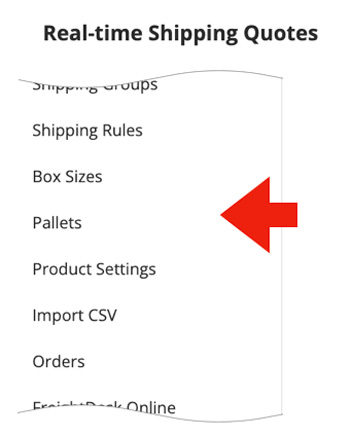
When the Pallet Packaging add-on is in use, it allows merchants to identify the sizes of pallets or handling units that are kept on hand for shipping. You don’t need to enable this optional, usage-based feature if your pricing tariff is based exclusively on traditional freight classes. However, if your pricing tariff requires that your shipments be dimensionally rated then you will need to enable this feature. Product dimensions are required when this add-on is in use.
When the activity of an online shopper triggers the need for LTL shipping quotes, the packaging algorithm will select the smallest pallet possible from your list of identified pallets. The selected pallet will be the one with a width or length greater but closest in size to the item in the cart with the largest dimension. If there is more than one possibility, the pallet with the smallest square area (length x width) will be chosen. This ensures the greatest edge-to-edge coverage on the pallet and therefore the lowest shipping costs when shipments will be dimensionally rated.
When the Pallet Packaging add-on is enabled, the packaging solution is saved as a step-by-step graphical illustration which you can access from the Order Details page. Use the step-by-step instructions to pack the order exactly as it was quoted.

Charges for the Pallet Packaging feature are usage based and are in addition to the monthly subscription you pay for the app. Plans for the Pallet Packaging add-on begin at $5/month for 100 transactions, or 5¢ per transaction when the plan is fully depleted. Other plans are available. The largest plan will drop the rate to 1¢ per transaction when it is fully depleted. (View all subscription plans)
When the Pallet Packaging add-on is enabled, a transaction occurs each time a packaging solution is obtained. A packaging solution is obtained prior to sending a request for shipping quotes to your enabled LTL freight providers. If a visitor’s activity causes an additional request for shipping quotes and the contents of the cart have not changed, then the previously obtained packaging solution is used and an additional transaction will not occur.
Subscription plans renew when the current one expires or is fully depleted, whichever occurs first. To change plans, select a new option from the Auto-renew setting. When the current plan expires or is fully depleted, the new plan will be in effect.
| Auto-renew | Select the plan that best meets your needs. Plans renew when the current one expires or is fully depleted, whichever occurs first. To change plans, select a new option from the Auto-renew setting. When the current plan expires or is fully depleted, the new plan will be in effect. |
| Current plan | Informs you about the details of the plan currently in use. |
| Current usage | Identifies the number of transactions that have been used on the current plan. |
| Suspend use | Enable this setting if you wish to temporarily disable this feature. This setting doesn’t disable the feature, it merely suspends it. If you encounter the end of a billing cycle with the feature suspended, the feature will be renewed for the plan you have selected in the Auto-renew setting. To disable the feature, select Disable from the Auto-renew setting dropdown. |
When the Pallet Packaging add-on is enabled, the app’s navigation will display Pallet Packaging in the Add-ons section. Click on it to gain access to the Pallet Packaging settings. Use the Add Pallet button to introduce a new pallet or handling unit. Use the Edit link adjacent to an existing entry to edit its properties, or the Delete link to remove it.
| Nickname | Enter a nickname for the pallet or handling unit. The nickname you enter will be used to identify it in the packaging solution illustration. It won’t be visible to your customer. |
| Length | Enter the length of the handling unit in inches. Fractional values can be entered after the decimal point (e.g. 1/8 inch = .125). |
| Width | Enter the width of the handling unit in inches. Fractional values can be entered after the decimal point (e.g. 1/8 inch = .125). |
| Max Height | Enter in inches the maximum height of the material that can be loaded on the handling unit. This excludes the height of the handling unit. Fractional values can be entered after the decimal point (e.g. 1/8 inch = .125). |
| Pallet Height | Enter the height of the handling unit (unloaded) in inches. Fractional values can be entered after the decimal point (e.g. 1/8 inch = .125). |
| Max Weight | Enter in pounds the maximum weight of the material that can be loaded on the handling unit. This excludes the weight of the handling unit. Fractional values can be entered after the decimal point (e.g. 1/8 pound = .125). |
| Pallet Weight | Enter the weight of the handling unit (unloaded) in pounds. Fractional values can be entered after the decimal point (e.g. 1/8 pound = .125). |
| Pallet Fee | Enter the amount you’d like to add to shipping rate estimates to cover the cost of the handling unit and other expenses. |
| Max Height w/ Pallet | Read only. Displays the maximum height of the loaded handling unit. It is the sum of the fields Max Height and Pallet Height. |
| Max Weight w/ Pallet | Read only. Displays the maximum weight of the loaded handling unit. It is the sum of the fields Max Weight and Pallet Weight. |
| Available | Enable this setting to make the handling unit available to the packaging algorithm. |
14. Product Settings. |
Return to top. |
Select Product Settings from the app’s navigation menu.
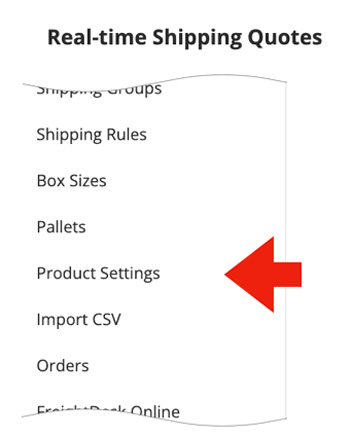
The Product Settings tab is used to enter or edit the shipping parameters of the products in your store catalog. Making use of the user interface on the Product Settings page works well if you are entering or editing a handful of products. To update a large number of products, you’ll find it much faster to use the CSV Utility described later in this User’s Guide.
Click on the Edit menu to access a product’s shipping parameters using the user interface. Enter the information prompted for and then click the Save button to return to the list of products.
| Default shipping method | One of these checkboxes must be enabled for the app to return shipping rates during the checkout process.
Quote as a parcel shipment
Enable this checkbox if the item would ship via a parcel carrier if it is the only thing in the Cart with a quantity of one. It’s possible for products that have the Quote as a parcel shipment setting enabled to also receive LTL freight quotes on the checkout page. In certain cases, it is also possible for only only LTL freight rates to be presented. Learn more. Quote as an LTL shipment
Enable this checkbox if the item would ship via an LTL carrier if it is the only thing in the Cart with a quantity of one. div>Only show options for in-store pickup and/or local delivery |
| Freight Class | Required for LTL freight. Recommended for products with the Quote as an parcel shipment setting enabled if one of the LTL freight providers is also enabled in the app.
Select the product’s freight class from the drop down list. You may also select Density Based from the list, which will calculate a freight class on the fly using the product’s weight and dimensions. Although the density based calculation will return a freight class, selecting the actual freight class for the product is recommended since density is only one of four factors that the National Motor Freight Transportation Agency (NMFTA.org) evaluates when identifying a commodity’s freight class. You are solely responsible to identify the correct freight class of your product(s). If you need assistance, start by checking out this resource for some useful tips: Learn more about Freight Classes |
| NMFC | NMFC numbers are not typically required to obtain a shipping rate estimate for LTL freight. Unless your LTL freight provider requires it, leave this setting blank. |
| Weight | Required. Enter the weight of the product in pounds. You can enter weights out to three decimal places. Consider including the weight of any packaging materials that may be required to ship the product, such as cardboard, pallets and shrink wrap. |
| Length | Required for parcel quotes if the Standard Box Sizes feature is in use. Not required for LTL freight quotes, but if the item would be subject to the LTL carrier’s overlength fee (also called the excessive length fee) you should populate the length field.
Enter the length of the product in inches. You can enter up to three digits to the right of the decimal point. Include any incremental inches added by packaging materials that may be required to ship the product. |
| Width | Required for parcel quotes if the Standard Box Sizes feature is in use. Not required for LTL freight quotes.
Enter the width of the product in inches. You can enter up to three digits to the right of the decimal point. Include any incremental inches added by packaging materials that may be required to ship the product. |
| Height | Required for parcel quotes if the Standard Box Sizes feature is in use. Not required for LTL freight quotes.
Enter the height of the product in inches. You can enter up to three digits to the right of the decimal point. Include any incremental inches added by packaging materials that may be required to ship the product. |
| HS Code | If you ship internationally, enter the product’s HS Code (Harmonized System Code) to have the quoted shipping rates reflect the landed cost for the shipment. |
| Markup | Enter a dollar amount (e.g. 5.00 for $5.00) or a percentage (e.g. 5.0% for five percent) to mark up the shipping charges when this item is in the cart. Leave this field blank if you don’t want the inclusion of this product in the cart to be the reason why the shipping quotes that are returned by the carrier are modified.
A dollar amount will be multiplied by the quantity of the item that is in the cart and the result added to the shipping quotes that are returned from the carrier before any markups on the Quote Settings page are applied. A percentage will be applied to the total value of the item in the cart (price x quantity x (1 + markup percentage)) and the result added to the shipping quotes that are returned from the carrier before any markups on the Quote Settings page are applied. |
| Insurance | Enable this setting if you want the shipment insured if this product is in the cart.
Insurance is not a supported setting for all carrier integrations. The following integrations will include the cost for insurance if this setting is enabled and the carrier is enabled in the application.
LTL Providers:
SAIA, Worldwide Express Parcel Providers:
FedEx, UPS, Worldwide Express |
| Hazardous material | Enable this setting if the product is subject to hazardous materials restrictions and fees. |
| Nested item | Enable this checkbox if the item can be stacked into another identical item when it is shipped. An example would be 13 gallon trashcans or plastic cups. When this setting is enabled, for LTL freight, the Freight Class is always Density Based.
Nested dimension
Identify the dimension (length, width or height) on which the nesting occurs. Nesting %
Enter the percent of the item that can be nested inside of another identical item. For example, if an item is 10 inches in height and after stacking two together the total height is 11 inches, the stacking percentage is 90%. (11 inches = 10 inches + (10 inches x (1-90%))) Maximum nested items
Enter the maximum number of items you’ll allow in a single stack of nested items. Stacking property
Select Maximized or Evenly. If your Maximum nested items is 6, and there are 7 items in the cart, then the Maximized option will result in one stack of 6 and one of 1. If the Stacking property is set to Evenly, it will result in one stack of 4 and one of 3. |
| Drop ship this product | Check this box if this item is drop shipped from a location other than your warehouse.
Drop ship location
A drop down field will display when the Drop ship this product setting is enabled. Select the drop ship location from the drop down. These locations are defined on the Warehouses page in the app settings that was described in the section titled Warehouses. |
| Assign this product to a shipping group | This setting is only relevant if you don’t want real-time shipping rates from your enabled shipping providers for this product. Shipping groups can be used in place of real-time shipping rates for things like free shipping or flat rate shipping. Refer to the section titled Shipping Groups for more information about shipping groups and instructions on how to create them.
Enabling the Assign this product to a shipping group setting will reveal a dropdown list of defined shipping groups. Select the shipping group you want to assign the product to. |
| Used by the Distance Based Shipping Rates integration | The Distance Based Shipping Rates integration allows for the creation of shipping classes to be used to represent groups of products. If you have the Distance Based Shipping Rates integration enabled, and this product is included in one of its shipping classes, enable the Assign this product to a shipping class checkbox and select the shipping class from the Shipping Class dropdown. |
| Boxing Properties | Allow item to be rotated vertically when placing it in a box Enable the setting to allow the packaging algorithm to rotate the item for ideal placement in a box. If the checkbox is left unchecked, the packaging algorithm will position the item in the box “standing up”. This item ships as its own package
Enable the setting if the item ships as its own package and should never be packaged in a box with other items that are in the cart. When enabled, the dimensions entered for the product will be used as the dimensions of the shipping unit. This item ships as multiple packages
Enable this setting if the items ships as multiple packages. If you enable the setting, locate the item in the section on the Box Sizes tab labeled These items ship as multiple packages and identify the various boxes that the item is comprised of. |
| Pallet Packing Properties | Allow vertical rotation on pallet Enable the setting to allow the packaging algorithm to rotate the item for ideal placement on a pallet. If the checkbox is left unchecked, the packaging algorithm will position the item on the pallet “standing up”. Ship as own pallet
Enable the setting if the item ships as its own handling unit (e.g. pallet or crate). When enabled, the dimensions entered for the product will be used as the dimensions of the shipping unit. |
15. Updating Products with the Import CSV Utility or API. |
Return to top. |
Using the app’s user interface is the simplest to populate the product shipping parameters (Step 14: Product Settings). However, if your store has a lot of products, using the app’s Import CSV Utility or its Product API will be more time efficient for people with sufficient technical skills. Which method is used will depend on the individual’s level of expertise. Instructions for both appear below.
You can’t use the Import CSV utility to create products in BigCommerce. The products must exist in BigCommerce prior to downloading the CSV template if they are to be updated.
Select Import CSV from the app’s navigation menu.
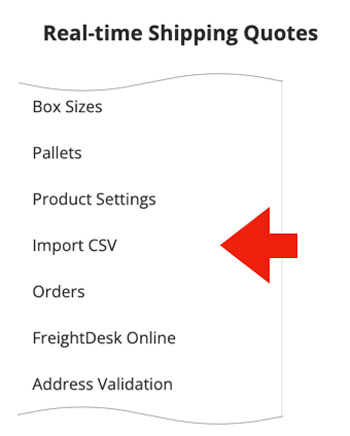
15a. Using the Import CSV Utility |
Return to top. |
You can use the app’s Import CSV utility to enter or update the product shipping parameters. This method can be more time efficient than navigating in and out of the app’s user interface, particularly if you have a lot of products.

Click the template link in the second paragraph of the on-screen instructions and provide your email address when prompted. You’ll receive an email containing the CSV file within a minute or two. The more products you have, the longer it takes to retrieve the data. If you don’t receive the email within 5 minutes, check your junk folder. The email’s subject line will be “Here is the CSV file you requested” and the sender’s email address will be support@eniture.com.
The email will contain a link that you will use to download a ZIP file. The ZIP file may contain more than one CSV file depending on the number of products and product variants you have in your catalog. Each file will contain a maximum of 2500 items.
Open the CSV file in Excel or a similar application. Each row of the spreadsheet represents one of your products or product variants. Eniture Technology publishes apps that provide quotes for Small Package (parcel) and LTL Freight. The CSV file can be used for both categories of apps. If you have more than one provider enabled in the app, you only need to import the file once
Save a copy of the CSV file as a backup, particularly if you have product shipping parameters already present. You can use the backup file to restore your product shipping parameters to their previous state in the event you make a mistake with your current update exercise.
Columns A and B contain important, unique identifiers from BigCommerce. Do not disturb these fields.
We recommend that you delete the rows from the CSV file that relate to products or product variants that you don’t want updated. Doing so will prevent these products from being updated in the event you make a mistake.
Removing data from a field in columns E and the columns afterward has the same effect as removing the data when using the user interface. If those columns were populated for a product when you received the CSV file, and you clear the data from them prior to importing the updated file, you’ll erase those shipping parameters.
| Column | Header | Instructions |
| A | Product id | This column is critical to the import process. Do not remove the column or modify its contents. |
| B | Variant id | This column is critical to the import process. Do not remove the column or modify its contents. |
| E | Weight | Required. Enter the weight of the item in pounds. You can can enter a value to the thousandths of a pound. For example, enter 1.125 for an item that weighs 1 pound and 2 ounces or 1 1/8 pounds. |
| F | Length | Enter the length of the item in inches. You can enter a value to the thousandths of an inch. For example, enter 1.125 for an item with a length of 1 1/8 inches. Length is always the longest dimension of the item.
Small Package Quotes LTL Freight Quotes
Refer to the section on how to use the user interface to populate the product shipping parameters to determine if you should enter dimensions for items that will ship LTL freight by default. It will indicate if dimensions are required for shipments to certain destinations or the excessive length fee. |
| G | Width | Enter the width of the item in inches. You can enter a value to the thousandths of an inch. For example, enter 1.125 for an item with a length of 1 1/8 inches.
Small Package Quotes LTL Freight Quotes
Refer to the section on how to use the user interface to populate the product shipping parameters to determine if you should enter dimensions for items that will ship LTL freight by default. It will indicate if dimensions are required for shipments to certain destinations. |
| H | Height | Enter the height of the item in inches. You can enter a value to the thousandths of an inch. For example, enter 1.125 for an item with a length of 1 1/8 inches.
Small Package Quotes LTL Freight Quotes
Refer to the section on how to use the user interface to populate the product shipping parameters to determine if you should enter dimensions for items that will ship LTL freight by default. It will indicate if dimensions are required for shipments to certain destinations. |
| I | Quote Method | Required. The default shipping method for the item. If you only have the Small Package Quotes app installed, enter S. If you only have the LTL Freight Quotes app installed, enter L. If you have both apps installed, enter S or L depending on which shipping method would be used if the cart contained only one unit of the item and no other items were in the cart. If left blank, the app will ignore the product.
S = Small Package (Parcel) |
| J | Freight Class | Required only if an LTL freight provider is enabled. If so, you should enter a freight class on all products, even those that will ship small package (parcel) by default. Small package products can be quoted as part of an LTL shipment depending on the content of the cart. Permitted values are: 50, 55, 60, 65, 70, 77.5, 85, 92.5, 100, 110, 125, 150, 175, 200, 225, 250, 300, 400, 500, Density Based.
Tip: To set the freight class to Density Based, in the CSV file enter “DensityBased” (no space).
If you are unfamiliar with what freight classes and need to populate this column, the knowledge base article What is a freight class? is a good resource to start with.
|
| K | NMFC | Do not populate this field unless you want to get LTL freight quotes and your pricing tariff requires an NMFC number to get a rate quote. To confirm if this is the case, log into your LTL provider’s website and get a rate quote. If you can do so without providing an NMFC number, then leave this field blank. (NMFC numbers can be thought of as a “sub-freight class” and are rarely required for the purpose of obtaining a LTL freight rate quote.) |
| L | Hazmat | This setting will be operational only if you are subscribed to a plan which includes the feature.
0 = The item isn’t hazardous material. An empty field is the equivalent of entering a 0. |
| M | Insurance | 0 = Don’t quote insurance because this item is in the cart. 1 = If this item is in the cart, include insurance in the shipping quotes.An empty field is the equivalent of entering a 0. |
| N | Dropship Nickname | Only populate this field if the item will be quoted as shipping from a dropship location and not a warehouse. The nickname is for your internal use only and has no affect on the quotes displayed to online shoppers. |
| O | Dropship Zip Code | Only populate this field with a postal code if the item will be quoted as shipping from a dropship location and not a warehouse. |
| P | Dropship City | Only populate this field with a city if the item will be quoted as shipping from a dropship location and not a warehouse. |
| Q | Dropship State | Only populate this field with a state or province if the item will be quoted as shipping from a dropship location and not a warehouse. |
| R | Dropship Country | Only populate this field with a two character country code (e.g. “US”/”CA”) if the item will be quoted as shipping from a dropship location and not a warehouse. |
| S | Boxing Properties | Setting this parameter to a value between 1 and 4 affect the programming only if the Standard Box Sizes feature is enabled.
0/Null = No setting. Without the Standard Box Sizes feature enabled, each item will be quoted as shipping as its own package. |
| T | Pallet Properties | Setting this parameter to a value between 1 and 4 affect the programming only if the Pallet Packing feature is enabled. The Pallet Packing feature is not required in most cases.
0/Null = No setting. Without the Pallet Packing feature enabled, LTL freight quotes are based on the total weight per freight class. |
| U | Markup | This parameter can be entered as a positive or negative currency or as a percentage. For example:5.00 will add $5 to the shipping rate estimate. It will be extended by the number of the item in the Cart. If 10 of this item are in the Cart, $50 (= 10 x $5) will be added to the shipping rate estimate.
-5.00 will subtract $5 from the shipping rate estimate. It will be extended by the number of the item in the Cart. If 10 of this item are in the Cart, $50 (= 10 x $5) will be subtracted from the shipping rate estimate. The shipping rate estimate will not be allowed to be less than zero. 5.00% will add 5 percent of the extended price of the item in the Cart to the shipping rate estimate. If the item’s price is $10, and 10 of it are in the Cart, then $5 will be added to the shipping rate estimates. (= $10 x 10 x 0.05) |
| V | Nested Item | 0 = Item isn’t nested during packaging.
1 = Item is nested during packaging.
An empty field is the equivalent of entering a 0.
|
| W | Nested Dimension | Enter the dimension that is impacted by nesting the product. Permissible values: length width height |
| X | Nesting % | Enter the percentage that represents the nesting behavior. Do not enter the trailing percent symbol. If the nesting behavior is that 90 percent of the second item nests into the first, then enter “90”.
Drinking glasses example:
The height of a drinking glass is 10 inches. If stacking a second one adds 1 inch to the total height of the glasses for shipping purposes, then 90% of the second glass is nested and “90” should be entered as the nesting percentage. Therefore, the total height of the two nested glasses is 11 inches (= 10 inches for the first glass plus 10 inches minus 9 inches for the second glass). |
| Y | Maximum Nested Items | Enter the maximum number of items that is permitted for each nested stack. Enter the value as an integer. |
| Z | Stacking Property | Enter the value for how the items should be stacked in the event that more than one stack will be created. The maximum number of items in each stack is governed by the setting in the previous column.
Maximized = Maximize the height of each stack before creating a new one.
Evenly = Make the stacks even in size.
|
Save the file as a CSV or Comma Separated Value file. If you are using a Mac, you’ll need save the file as a Windows Comma Separated (.csv) or MS-DOS Comma Separated (.csv) file, or the import process will not be successful.To import your populated CSV file, navigate to the Import CSV tab in the app preferences. Click the box to indicate that your file has a header row (if it still does), and then click the Choose File button. Select your file and click the Next button.
On the next page, use the drop down lists on the right to map the column headers in your file to the shipping parameters listed on the left. When the mapping is done, click Next.
You’ll be prompted to provide an email address which will receive an email once the import is done. The email will contain information about the outcome of the import process. The import process typically takes 5 minutes or less. If you don’t receive a notification email within 10 minutes, check your spam folder and make sure the notification email isn’t there. If it isn’t, download the CSV template again. Examine the new file you receive to see if your updates are reflected in the data. If they aren’t, email the CSV file that contains your updates to support@eniture.com.
15b. Using the Product API |
Return to top. |
You can use the app’s Product API to enter or update the product shipping parameters. This method can be more time efficient than navigating in and out of the app’s user interface, particularly if you have a lot of products. To locate information on the Product API click on Import CSV in the app’s navigation menu and scroll to the bottom of the page.
To use the Product API, you’ll need an API token. If it is present, click on the copy icon to copy it to your clipboard. If the API token isn’t present, or you need to generate a new one, first click on the Create button.
Documentation for the Product API can be accessed using the following link:
16. Orders |
Return to top. |
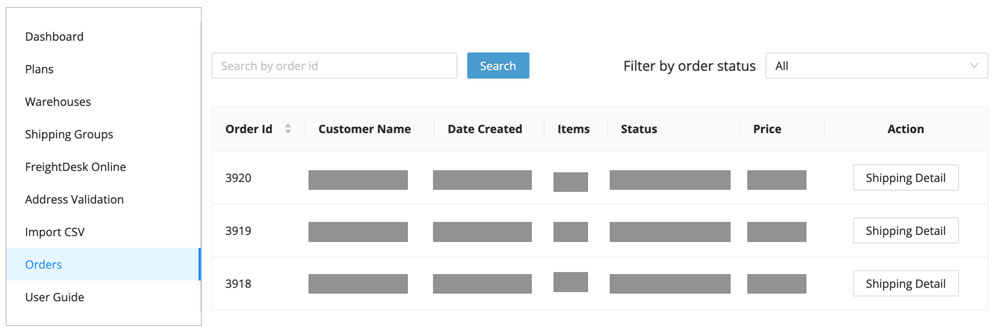
The Orders page lists the orders that have been placed on your store. Its primary purpose, in the context of the app, is to provide information about the shipping quote that was selected during the checkout process. The information provided includes the shipping origins, the shipping service, the amount of the quote, a list of the additional services included in the quote, and a list of the items (by shipping origin) on each shipment. If you have the Standard Box Sizes add-on app enabled, the Shipping Detail page will also have a graphical illustration of the packaging solution complete with step-by-step instructions on how the box was packed. The Standard Box Sizes add-on app is relevant only to parcel and postal providers.
Click an order’s Shipping Details button to view the details of the shipping quote selected during checkout.
What your customer sees |
Return to top. |
What your customer sees will depend on the shipping providers you activated and the settings you’ve enabled. Shipping estimates are obtainable on the Cart page and the Checkout page. Below are examples of what a customer would see on both pages. Depending on the circumstance of the checkout, it is also possible for the shopper to be presented with both parcel and LTL freight quotes. Learn more.


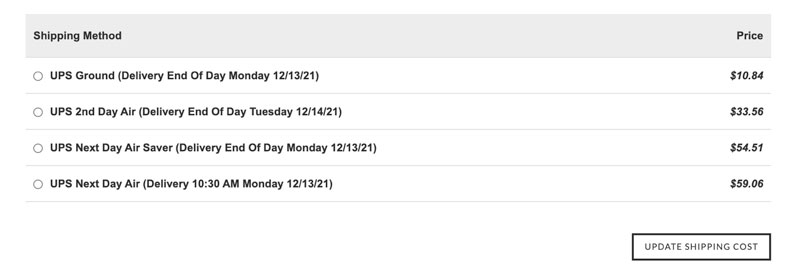
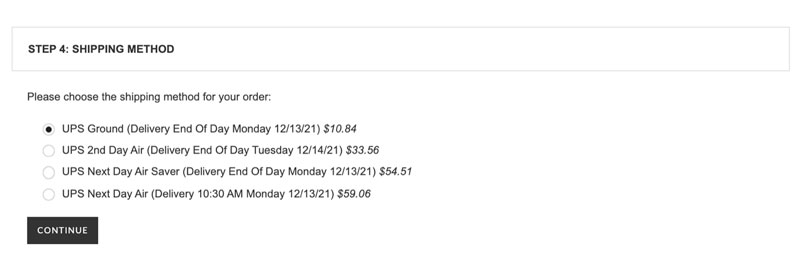
Shipping with FreightDesk Online |
Return to top. |
- How capture the cost of shipping on orders placed online.
- How to ship the order, including how to create the shipping label (or Bill Of Lading in the case of LTL freight), schedule the carrier to pick up the shipment, and update the customer with the tracking number.
Quoting apps, like this one, provide a solution for the first challenge. What are your options for the second challenge?
Option 1 – The carrier’s website: You can log into the carrier’s website and manually enter all of the relevant information. Carrier websites are free to use since the carrier makes money when you use them to deliver an order. However, if you have more than a handful of orders each day this approach is time consuming and ripe for data entry errors which can be costly to correct.
Option 2 – Cloud-based Shipping Platforms: The next step up in capability are cloud-based shipping systems that will connect to your online store and retrieve the details of your orders, thereby eliminating the need for much of the manual data entry. Many of these shipping systems have arrangements with postal and parcel carriers that give subscribers access to discounted rates that they’d be unable to obtain on their own. Where these systems excel is in the efficiency of the fulfillment process. That translates to a much higher volume of shipments per unit of time. These systems are relatively inexpensive and the reduction in the amount of labor and time it takes to ship your orders will pay dividends.
Option 3 – FreightDesk Online: FreightDesk Online (freightdesk.online) is also a cloud-based shipping system. It enjoys all of the benefits of other cloud-based offerings but expands the solution in two ways:
- It makes use of the detailed information collected by Eniture Technology’s quoting apps (like this one) such as the packaging solution and the additional services included in the shipping option chosen when the order was placed.
- It provides merchants access to more than two dozen LTL freight providers in addition to the typical postal and parcel integrations offered by other cloud-based solutions.
These expanded capabilities deliver you closer to true “click-and-ship” shipping than any other alternative, whether you’re shipping with a postal carrier, a parcel carrier, or an LTL freight provider.
How to connect your BigCommerce store to FreightDesk Online |
Return to top. |
First, if you don’t already have one, register for a FreightDesk Online account (https://freightdesk.online/register). You can connect multiple online stores to FreightDesk Online, so you don’t have to create separate accounts for each one.
The pricing for FreightDesk Online is á la carte. You’ll be able to pick a separate plan for parcel (and postal) shipments, and for LTL freight shipments based on the anticipated volume for each type of shipping. Your monthly subscription rate will be comprised of these two selections. You can begin a 30-day trial of both types of shipping by selecting Trial in the corresponding dropdown fields on the registration form.
After you complete the registration process, log into FreightDesk Online. Click on your avatar located in the top right-hand corner of the browser window. Copy your FreightDesk Online ID which will be located below your company name.
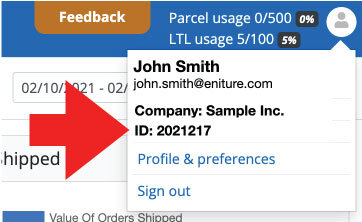
Return to the BigCommerce ADMIN area. Click Apps and then Real-time Shipping Quotes by Eniture Technology. In the app’s navigation menu, select FreightDesk Online.

Enter your FreightDesk Online ID and then click the Connect button.
Now that you’ve connected FreightDesk Online, unfulfilled orders will automatically appear in FreightDesk Online. To view them, log into FreightDesk Online and click on Orders in the navigation menu. You’ll need to connect your shipping providers before you can start shipping. You can find a quick start guide in FreightDesk Online by navigating to Help > Getting Started.
Using Validate-Addresses.com |
Return to top. |
Validate-Addresses.com is a cloud-based application that validates the ship-to address on online orders. The validation happens after the order is received so there isn’t additional friction during the checkout process that could increase the Cart abandonment rate. Shipping to an invalid address is costly. Shipping providers charge hefty fees to follow up on and correct undeliverable addresses, and additional transportation charges will be incurred if the shipment has to be redirected to a different terminal for delivery. If the shipment is returned to the shipper, the transportation charges will double in addition to the fees. Validate-Addresses.com costs as little as 1¢ per order and can be the difference between making money, or losing hundreds of dollars on an order.
– Benjamin Franklin
How does Validate-Addresses.com work?
As soon as the order is placed, the order status is set to Manual Verification Required or another status of your choosing until after Validate-Addresses.com confirms that the ship-to address is valid. If the ship-to address is valid, then the order status is changed to indicate that it is safe to process the order and shipment and the order notes are updated to document that the ship-to address was good. The time between an order being placed and the validation of the ship-to address is typically 2 to 3 seconds.
Validate-Addresses.com can be configured to automatically email the customer if the order’s ship-to address is invalid, provide the customer with options on how to correct it, or the option to confirm it as entered. If the customer corrects the address, the address is rechecked. If the corrected address is valid, or if the customer confirmed the address as entered, the order status in BigCommerce is updated to indicate that it is safe to process and the order notes are updated to document the event. The merchant’s involvement in this process is completely hands off. The order status will remain Manual Verification Required until the address is corrected or confirmed so the merchant knows not to ship the order.
There will be times when an order’s ship-to address can’t be validated and the customer fails to respond to the email notices about the invalid ship-to address. (You can configure these notices to reflect your brand and customize the message.) In these cases the merchant can contact the customer and if the outcome is favorable, override the Manual Verification Required status in Validate-Addresses.com. Afterward, the order status in BigCommerce will be updated to indicate that it is safe to process, and the address will be added to the merchant’s address book so that future orders using the address won’t be flagged as invalid.
How to connect your BigCommerce store to Validate-Addresses.com |
Return to top. |
Register for a Validate-Addresses.com account (https://validate-addresses.com/register). You can connect multiple online stores to Validate-Addresses.com, even if they use different e-commerce platforms, so you don’t have to create separate accounts for each one.
After you complete the registration process, log into Validate-Addresses.com. Click on your avatar located in the top right-hand corner of the browser window. Copy your ID number.

Enter your Validate-Addresses.com ID and then click the Connect button.

Return to the BigCommerce ADMIN area. Click Apps and then Real-time Shipping Quotes by Eniture Technology. In the app’s navigation menu, click on Address Validation.
Now that you’ve connected to Validate-Addresses.com, return to Validate-Addresses.com and review the connection settings for your store. In Validate-Addresses.com, navigate to Settings > Connections and locate the store in the list of Connected Marketplaces. Click on the Show/Edit link in the right hand margin to reveal the available settings. Use the instructions below to update the settings to reflect your preferences.
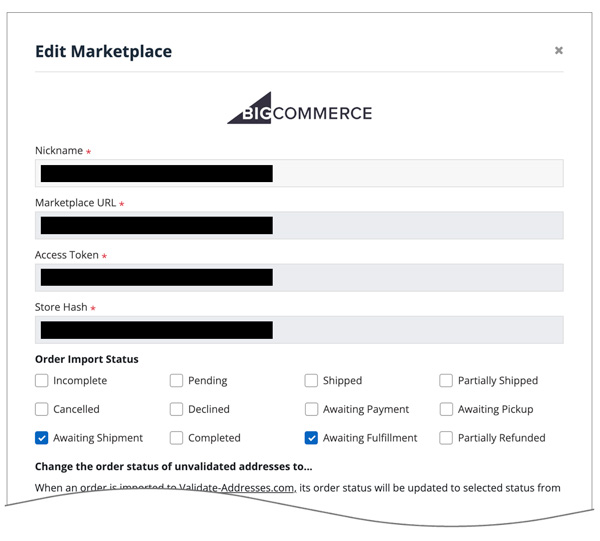
| Order Import Status | Enable the checkboxes next to the BigCommerce order statuses you want Validate-Addresses.com to process. The most common selections are Awaiting Shipment and/or Awaiting Fulfillment. Processing is typically the only order status enabled. |
| Change the order status of unvalidated addresses to… | Choose the order status that you’d like to assign to new orders whose ship-to addresses are pending address validation. Good addresses are usually validated within 2 to 3 seconds. If an address can’t be validated, then its order status will continue to reflect this status until the customer confirms it, changes it, or action is taken by the merchant. |
| After validating the address, change the order status to… | Choose the order status you want to update the order with after the ship-to address has been validate or confirmed. |
| Marketplace Status | Select Activate Marketplace to enable the store’s connection to Validate-Addresses.com. To disable it, choose Inactive Marketplace. |
Now that you’ve connected Validate-Addresses.com, orders that meet your settings will automatically propagate the system. Orders that have ship-to addresses that were validated, corrected, or confirmed will appear on the Validate-Addresses.com History page and their status will appear as per your settings on the BigCommerce Orders page. Orders with ship-to addresses that require attention will appear on the Validate-Addresses.com Orders page and their status on the BigCommerce Orders page will reflect the value you specified. Use the Validate-Addresses.com Orders page to work on the ship-to address of orders that require attention.
To enable the ship-to address correction/confirmation process, which begins with an email to the customer when an invalid address is discovered, you must first configure your outbound mail server settings. In Validate-Addresses.com navigate to Settings > Email Setup. Afterward, navigate to Settings > Email Template to customize the content of the email your customer will receive.
Validate-Address.com has extensive online instructions and help. Explore the app and its functionality. An excellent place to begin is Settings in Validate-Addresses.com’s navigation menu. In Settings, start with Setup Instructions and afterward the options for Email Setup and Email Template. These will automate the address correction process when an invalid ship-to address is provided on an order.
Logs |
Return to top. |
The Quote Settings pages contain the Enable Logs setting. When enabled, up to 25 of the most recent transactions for the associated shipping provider will appear on the Logs page. The Response column shows the outcome of each transaction. Click on a transaction’s response result to view its details.
When viewing the transaction details, click on the “+” symbols to expand the level of detail and “–” to collapse it. A basic understanding of Application Programming Interfaces (APIs) will be useful when viewing the logs.
Related document:
Using Logs In Quoting Apps From Eniture Technology

